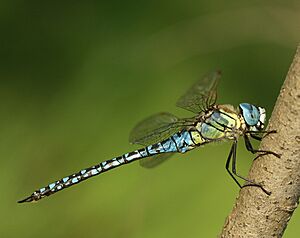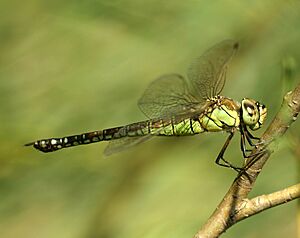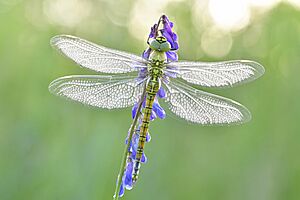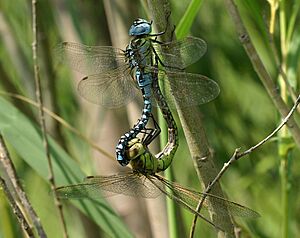Southern migrant hawker facts for kids
Quick facts for kids Migrant hawker |
|
|---|---|
 |
|
| Male A. affinis | |
 |
|
| Female A. affinis | |
| Scientific classification |
The Southern Migrant Hawker, also known as the Blue-Eyed Hawker, is a type of dragonfly. Its scientific name is Aeshna affinis. You can find this dragonfly in southern Europe and many parts of Asia. It belongs to a group of dragonflies called Aeshnidae. It looks a lot like another dragonfly called A. mixta.
What Does It Look Like?
The Southern Migrant Hawker is a smaller type of Aeshna dragonfly. It is very similar to its relative, A. mixta, which can make them hard to tell apart. As its name suggests, the male Southern Migrant Hawker has bright blue eyes. It also has blue markings on its body, especially on its abdomen.
One way to tell it apart is that A. affinis does not have a yellow T-shaped mark. This mark is usually found on the top of the second part of the abdomen in A. mixta. The markings on the sides of their bodies are also different. The Southern Migrant Hawker has greenish-yellow sides with thin black lines. In A. mixta, the yellow parts are separated by dark brown areas. This makes A. mixta look like it has two wide yellow stripes.
Where Does It Live?
You can find the Southern Migrant Hawker in southern and central Europe. It also lives all around the Mediterranean Sea, including North Africa and the Middle East. Its home range stretches across Asia all the way to China. It lives on many islands in the Mediterranean, such as Menorca, Corsica, and Sicily.
Where it lives in the same areas as A. mixta, which prefers cooler northern places, A. affinis is less common. This dragonfly is a migrant species. This means it can travel further north in years when the weather is good.
Life Cycle and Behavior
Adult Southern Migrant Hawkers usually appear in May. They can be seen flying until September. After they first come out, the young adults fly away from the water. They spend time eating and growing until they are ready to mate. This period can last from 10 days to several weeks.
Male Southern Migrant Hawkers often fly low to the ground. In contrast, A. mixta males tend to fly higher up in trees. Once they are ready to mate, the males fly over ponds and lakes that have lots of plants. They are looking for females. When a male finds a female, he will grab her, and they will mate.
The Southern Migrant Hawker is special because it is the only Aeshna dragonfly in Europe that lays its eggs while still connected to its mate (in tandem). The only other European hawker dragonfly that lays eggs this way is Anax parthenope. The young dragonflies, called larvae, usually live in the water for two years before they become adults.
See also
 In Spanish: Aeshna affinis para niños
In Spanish: Aeshna affinis para niños



